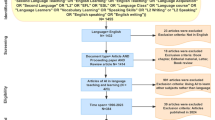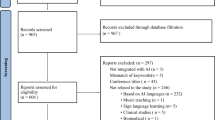Abstract
Nowadays, hardly anyone working in the field of foreign language teaching and learning can imagine life without machine translation (MT) tools. Thanks to the rapid development of artificial intelligence, MT now most widely assumes a new form, the so-called Neural Machine Translation (NMT), which offers the potential for a wide application in foreign language learning (FLL). Therefore, the purpose of this review study is to explore different approaches to the efficient implementation of NMT into FLL and provide specific pedagogical implications for best practices. The PRISMA methodology for systematic reviews and meta-analyses was strictly followed. The search was conducted in two well-established databases, specifically Scopus and Web of Science, to generate sufficient data from research articles for further analysis. The findings of this systematic review indicate that NMT is an efficient tool for developing both productive (speaking and writing) and receptive (reading and listening) language skills, including mediation skills, which are relevant for translation. Moreover, the results show that NMT tools are especially suitable for advanced learners of L2, whose higher proficiency level enables them to critically reflect on the output of NMT texts more than beginners or lower-intermediate learners. Thus, the findings of this review study reveal that NMT has valuable implications for L2 pedagogy since it can serve as a very powerful online reference tool for FLL provided that teachers introduce students to its benefits but also limitations by implementing various teaching approaches.
Similar content being viewed by others
Explore related subjects
Discover the latest articles, news and stories from top researchers in related subjects.Data Availability
The datasets generated for this study are available on request from the corresponding author.
References
Alm, A. (2021, August). Taking tools into their own hands: Independent learner use of Machine Translation to proofread L2 academic writing. Paper presented at the Eurocall 2021 Conference, online
Bender, E. M., Gebru, T., McMillan-Major, A., & Shmitchell, S. (2021). On the dangers of stochastic parrots: can language models be too big? Proceedings of the 2021 ACM Conference on Fairness, Accountability, and Transparency (FAccT ‘21) (pp. 610–623). Association for Computing Machinery
Borodina, M., Golubeva, T. I., Korotaeva, I. E., Shumakova, S. Y., Bessonova, T. V., & Zharov, A. N. (2021). Impact of the Google translate machine translation system on the quality of training student translators. Webology, 18, 68–78
Briggs, N. (2018). Neural machine translation tools in the language learning classroom: Students’ use, perceptions, and analyses. JALT CALL Journal, 14(1), 3–24
Chen, W. (2020). Using Google Translate in an authentic translation task: The process, refinement efforts, and students’ perceptions. Current Trends in Translation Teaching and Learning E, 7, 213–238
Chung, E. S., & Ahn, S. (2021). The effect of using machine translation on linguistic features in L2 writing across proficiency levels and text genres. Computer Assisted Language Learning, 1–26. doi: https://doi.org/10.1080/09588221.2020.1871029
Chung, E. S. (2020). The effect of L2 proficiency on post-editing machine translated texts. Journal of Asia TEFL, 17(1), 182–193
Delorme Benites, A., Cotelli Kureth, S., Lehr, C., & Steele, E. (2021). Machine translation literacy: a panorama of practices at Swiss universities and implications for language teaching. In N. Zoghlami, C. Brudermann, C. Sarré, M. Grosbois, L. Bradley, & S. Thouësny (Eds), CALL and professionalisation – short papers from EUROCALL 2021 (pp. 1–8). Research-publishing.net
Delorme Benites, A., & Lehr, C. (2021). (in press). Neural machine translation and language teaching – possible implications for the CEFR. Bulletin Suisse de Linguistique Appliquée, 2
Ducar, C., & Schocket, D. H. (2018). Machine translation and the L2 classroom: Pedagogical solutions for making peace with Google Translate. Foreign Language Annals, 51, 779–795
Jones, R. H. (2019). The text is reading you: teaching language in the age of the algorithm. Linguistics and Education, 62, 100750
Enkin, E., & Mejias-Bikani, E. (2016). Using online translators in the second language classroom: ideas for advanced-level Spanish. Latin American Journal of Content and Language Integrated Learning, 9(1), 138–158
Forcada, M. (2017). Making sense of neural machine translation. Translation Spaces, 6(2), 291–309
Fredholm, K. (2019). Effects of Google translate on lexical diversity: vocabulary development among learners of Spanish as a foreign language. Revista Nebrija de Lingüística Aplicada a la Enseñanza de las Lenguas, 13(26), 98–117
Groves, M., & Mundt, K. (2015). Friend or foe? google translate in language for academic purposes. English for Specific Purposes, 37, 112–121
Hellmich, E. A. (2019). A critical look at the bigger picture: macro-level discourses of language & technology in the US. CALICO Journal, 36(1), 39–58
Hellmich, E. A., & Vinall, K. (2021). FL instructor beliefs about machine translation: ecological insights to guide research and practice. International Journal of Computer-Assisted Language Learning & Teaching, 11(4), 1–18
Jiménez-Crespo, M. A. (2017). The role of translation technologies in Spanish language learning. Journal of Spanish Language Teaching, 4(2), 181–193
Johnson, M., Schuster, M., Le, Q. V., Krikun, M., Wu, Y., Chen, Z. … Dean, J. (2017). Google’s multilingual neural machine translation system: enabling zero-shot translation. Transactions of the Association for Computational Linguistic, 5, 339–351
Jolley, R., & Luciane, M. (2022). Thirty years of machine translation in language teaching and learning: A review of the literature. L2 Journal, 14(1), 26–44
Jones, R. H. (2019). The text is reading you: teaching language in the age of the algorithm. Linguistics and Education, 62, 100750
Kennedy, O. (2021). Taking tools into their own hands: Independent learner use of machine translation to proofread L2 academic writing. Eurocall 2021 (pp. 25–27). Online. Aug 2021
Kol, S., Schcolnik, M., & Spector-Cohen, E. (2018). Google translate in academic writing courses? The EuroCALL Review, 26(2), 50–57
Lee, S. M. (2021). The effectiveness of machine translation in foreign language education: a systematic review and meta-analysis. Computer Assisted Language Learning, 1–23. doi: https://doi.org/10.1080/09588221.2021.1901745
Lee, S. M. (2020). The impact of using machine translation on EFL students’ writing. Computer Assisted Language Learning, 33(3), 157–175
Liao, Y. (2021). Gender bias in neural machine translation. Senior Capstone Thesis, University of Pennsylvania. https://www.cis.upenn.edu/wp-content/uploads/2021/10/Senior_Thesis_Yuxin_Liao.pdf
Loock, R. (2020). No more rage against the machine: How the corpus-based identification of machine translationese can lead to student empowerment. The Journal of Specialised Translation, 34, 150–170
Maghsoudi, M., & Mirzaeian, V. (2020). Machine versus human translation outputs: Which one results in better reading comprehension among EFL learners? The JALT CALL Journal, 16(2), 69–84
Martindale, M. J., & Carpuat, M. (2018). Fluency over adequacy: a pilot study in measuring user trust in imperfect MT. Proceedings of AMTA 2018 (pp. 17–25). AMTA
Mundt, K., & Groves, M. (2016). A double-edged sword: the merits and the policy implications of Google Translate in higher education. European Journal of Higher Education, 6(4), 387–401
Murtisari, E. T., Widiningrum, R., Branata, J., & Riana, D. S. (2019). Google Translate in language learning: Indonesian EFL students’ attitudes. Journal of Asia TEFL, 16(3), 978–986
Niño, A. (2020). Exploring the use of online machine translation for independent language learning. Research in Learning Technology, 28, 2402
Niño, A. (2009). Machine translation in foreign language learning: Language learners´ and tutors´ perceptions of its advantages and disadvantages. ReCALL: the Journal of EUROCALL, 21(2), 241–258
Nunes Vieira, L., O’Hagan, M., & O’Sullivan, C. (2021). Understanding the societal impacts of machine translation: a critical review of the literature on medical and legal use cases. Information Communication & Society, 24(11), 1515–1532
O’Callaghan, J. (2014). Don’t bother learning a foreign language! Skype will soon translate spoken foreign words in real time. Daily mail. Retrieved on 20 December 2021 from: https://www.dailymail.co.uk/sciencetech/article-2641653/Dont-bother-learning-foreign-language-Skype-soon-let-translate-spoken-foreign-words-real-time.html
Olkhovska, A., & Frolova, I. (2020). Using machine translation engines in the classroom: A survey of translation students’ performance. Advanced Education, 15, 47–55
O’Neill, E. (2019a). Training students to use online translators and dictionaries: The impact on second language writing scores. International Journal of Research Studies in Language Learning, 8(2), 47–65
O’Neill, E. (2019b). Online translator, dictionary, and search engine use among L2 students. CALL-EJ: Computer-Assisted Language Learning-Electronic Journal, 20(1), 154–177
Phillips, V., & Barker, E. (2021). Systematic reviews: Structure, form and content. Journal of Perioperative Practice, 31(9), 349–353. https://doi.org/10.1177/1750458921994693
Ragni, V., & Nunes Vieira, L. (2021). What has changed with neural machine translation? A critical review of human factors. Perspectives, 30(1), 137–158
Ranathunga, S., Lee, E. S. A., Skenduli, M. P., Shekhar, R., Mehreen, A., & Kaur, R. (2021). Neural machine translation for low-resource languages: a survey.Computer Science: Computation and Language.https://arxiv.org/abs/2106.15115
Rucart, R. A. (2021, August). Potential and limitations of machine translation to learn English: the case of apprentice engineers. Paper presented at the Eurocall 2021 Conference, online
Schmalz, A. (2019). Maschinelle Übersetzung. In V. Wittpahl (Ed.), Künstliche Intelligenz (pp. 194–211). Berlin, Heidelberg: Springer Vieweg
Stapleton, P., Leung, K., & Kin, B. (2019). Assessing the accuracy and teachers’ impressions of Google Translate: A study of primary L2 writers in Hong Kong. English for Specific Purposes, 56, 18–34
Tsai, S. C. (2020). Chinese students’ perceptions of using Google Translate as a translingual CALL tool in EFL writing. Computer Assisted Language Learning, 1–23. doi: https://doi.org/10.1080/09588221.2020.1799412
Tsai, S. C. (2019). Using google translate in EFL drafts: a preliminary investigation. Computer Assisted Language Learning, 32(5–6), 510–526
Valijäriv, R., & Tarsoly, E. (2019). Language students as critical users of Google Translate: Pitfalls and possibilities. Practitioner Research in Higher Education, 12(1), 61–74
Vanmassenhove, E., Shterionov, D., & Gwilliam, M. (2021). Machine translationese: effects of algorithmic bias on linguistic complexity in machine translation. Proceedingsofthe16thConferenceoftheEuropeanChapteroftheAssociationforComputationalLinguistics:MainVolume (pp. 2203–2213). Association for Computational Linguistics
Wu, Y., et al. (2016). Google’s neural machine translation system: bridging the gap between human and machine translation. Retrieved on 20 December 2021 from: https://arxiv.org/abs/1609.08144
Yamada, M. (2019). The impact of Google Neural Machine Translation on post-editing by student translators. The Journal of Specialised Translation, 31, 87–106
Zhang, W., & Zhang, E. (2019). Application of neural network machine translation in college translation teaching. International Journal of Emerging Technologies in Learning (iJET), 14(19), 16–25
Zhu, X. (2020). Machine translation in foreign language learning classroom - Learners’ indiscriminate use or instructor’s discriminate stance. English Linguistics Research. Sciedu Press, 9(4), 1–5
Acknowledgements
This review study was supported by COST Action CA19102 project ‘Language in the Human-Machine Era’ (LITHME) as well as by Excellence project 2022, run at the University of Hradec Kralove, Czech Republic.
Funding
This research received no external funding.
Author information
Authors and Affiliations
Contributions
BK and MP conducted a conceptual design of the research and its methodology. All the authors (BK, MP, CS-S, ADB, CL) collected the data. ADB and CL drafted the Introductory chapter, BK and MP worked on the Results, Discussion and Conclusion parts. BK and MP revised the whole manuscript. CS-S edited the whole manuscript. All authors read and approved the submitted version of the manuscript.
Corresponding author
Ethics declarations
Disclosure of potential conflicts of interest
The authors have no conflicts of interest to declare.
Research involving human participants
Not applicable.
Informed consent
Not applicable.
Additional information
Publisher’s Note
Springer Nature remains neutral with regard to jurisdictional claims in published maps and institutional affiliations.
Rights and permissions
About this article
Cite this article
Klimova, B., Pikhart, M., Benites, A.D. et al. Neural machine translation in foreign language teaching and learning: a systematic review. Educ Inf Technol 28, 663–682 (2023). https://doi.org/10.1007/s10639-022-11194-2
Received:
Accepted:
Published:
Issue Date:
DOI: https://doi.org/10.1007/s10639-022-11194-2




